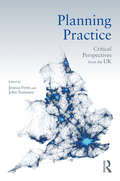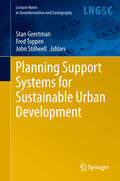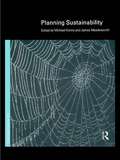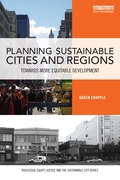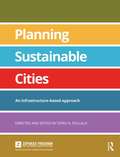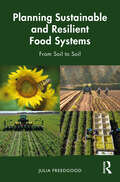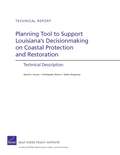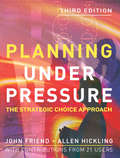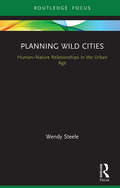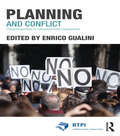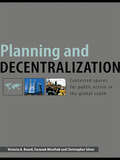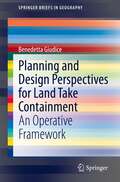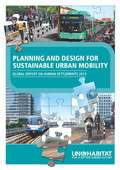- Table View
- List View
Planning Practice: Critical Perspectives from the UK
by John Tomaney Jessica FermPlanning Practice: Critical Perspectives from the UK provides the only comprehensive overview of contemporary planning practice in the UK. Drawing on contributions from leading researchers in the field, it examines the tools, contexts and outcomes of planning practice. Part I examines planning processes and tools, and the extent to which theory and practice diverge, covering plan-making, Development Management, planning gain, public engagement and place-making. Part II examines the changing contexts within which planning practice takes place, including privatisation and deregulation, devolution and multi-level governance, increased ethnic and social diversity, growing environmental concerns and the changing nature of commercial real estate. Part III focuses on how planning practice produces outcomes for the built environment in relation to housing, infrastructure, economic progress, public transport and regeneration. The book considers what it means to be a reflective practitioner in the modern planning system, the constraints and opportunities that planners face in their daily work, and the ethical and political challenges they must confront.
Planning Rural Landscapes: Green Infrastructure and Ecosystem Services Nexus (Routledge Research in Planning and Urban Design)
by Manuela Magalhães Cunha NatáliaAppealing to a broad audience, this book bridges different issues, from landscape to ecosystems, planning to implementation, and policies to local community willingness. This book outlines a methodology for defining green infrastructure (GI) in rural landscapes, showing how it underpins ecosystem services (ES) and aligns with various European Union (EU) directives. There are presented examples in Portuguese rural landscapes alongside international initiatives from several countries.Building on the concept of landscape as an open, autopoietic system with distinct resilience thresholds, the book demonstrates how GI serves as a versatile framework to support ES, implement nature-based solutions and the more recent Nature-Futures-Framework scenarios. Through real-world studies, the authors illustrate its flexibility and applicability across different scales and environments while respecting each location’s unique characteristics.Written for planners, designers, policymakers, and academic institutions, this book offers a valuable resource for supporting sustainable land management, public policy formulation, planning, and innovative design practices, fostering informed debate on these topics and advancing eco-conscious initiatives for a sustainable future.
Planning Singapore: The Experimental City (Planning, History and Environment Series)
by Belinda Yuen Stephen HamnettTwo hundred years ago, Sir Stamford Raffles established the modern settlement of Singapore with the intent of seeing it become ‘a great commercial emporium and fulcrum’. But by the time independence was achieved in 1965, the city faced daunting problems of housing shortage, slums and high unemployment. Since then, Singapore has become one of the richest countries on earth, providing, in Sir Peter Hall’s words, ‘perhaps the most extraordinary case of economic development in the history of the world’. The story of Singapore’s remarkable achievements in the first half century after its independence is now widely known. In Planning Singapore: The Experimental City, Stephen Hamnett and Belinda Yuen have brought together a set of chapters on Singapore’s planning achievements, aspirations and challenges, which are united in their focus on what might happen next in the planning of the island-state. Chapters range over Singapore’s planning system, innovation and future economy, housing, biodiversity, water and waste, climate change, transport, and the potential transferability of Singapore’s planning knowledge. A key question is whether the planning approaches, which have served Singapore so well until now, will suffice to meet the emerging challenges of a changing global economy, demographic shifts, new technologies and the existential threat of climate change. Singapore as a global city is becoming more unequal and more diverse. This has the potential to weaken the social compact which has largely existed since independence and to undermine the social resilience undoubtedly needed to cope with the shocks and disruptions of the twenty-first century. The book concludes, however, that Singapore is better-placed than most to respond to the challenges which it will certainly face thanks to its outstanding systems of planning and implementation, a proven capacity to experiment and a highly developed ability to adapt quickly, purposefully and pragmatically to changing circumstances.
Planning Support Systems and Smart Cities
by Jr. John Stillwell Stan Geertman Joseph Ferreira Robert GoodspeedThis book is a selection of the best and peer-reviewed articles presented at the CUPUM (Computers in Urban Planning and Urban Management) conference, held in the second week of July 2015 at MIT in Boston, USA. The contributions provide state-of the art overview of the availability and application of Planning Support Systems (PSS) in the framework of Smart Cities.
Planning Support Systems for Sustainable Urban Development
by John Stillwell Stan Geertman Fred ToppenThis book collects a selection of the best articles presented at the CUPUM (Computers in Urban Planning and Urban Management) conference, held in the second week of July 2013 in Utrecht, the Netherlands. The articles included were selected by external reviewers using a double blind process.
Planning Sustainability (Environmental Politics)
by James Meadowcroft Michael KennyEnvironmental sustainability has become one of the most salient issues on the policy agenda of nation-states. This book argues that planning is seldom credited by advocates of environmental politics. The authors, leading scholars in the field, explore the relationship between environmental sustainability - one of the most important innovations in recent political discourse and planning, an idea which has slipped from public attention recently.
Planning Sustainable Cities and Regions: Towards More Equitable Development (Routledge Equity, Justice and the Sustainable City series)
by Karen ChappleAs global warming advances, regions around the world are engaging in revolutionary sustainability planning - but with social equity as an afterthought. California is at the cutting edge of this movement, not only because its regulations actively reduce greenhouse gas emissions, but also because its pioneering environmental regulation, market innovation, and Left Coast politics show how to blend the "three Es" of sustainability--environment, economy, and equity. Planning Sustainable Cities and Regions is the first book to explain what this grand experiment tells us about the most just path moving forward for cities and regions across the globe. The book offers chapters about neighbourhoods, the economy, and poverty, using stories from practice to help solve puzzles posed by academic research. Based on the most recent demographic and economic trends, it overturns conventional ideas about how to build more livable places and vibrant economies that offer opportunity to all. This thought-provoking book provides a framework to deal with the new inequities created by the movement for more livable - and expensive - cities, so that our best plans for sustainability are promoting more equitable development as well. This book will appeal to students of urban studies, urban planning and sustainability as well as policymakers, planning practitioners, and sustainability advocates around the world.
Planning Sustainable Cities: An infrastructure-based approach
by Spiro N. PollalisPlanning Sustainable Cities: An infrastructure-based approach provides an analytical framework for urban sustainability, focusing on the services and performance of infrastructure systems. The book approaches infrastructure as a series of systems that function in synergy and are directly linked with urban planning. This method streamlines and guides the planning process, while still highlighting detail, each infrastructure system is decoded in four "system levels". The levels organize the processes, highlight connections between entities and decode the high-level planning and decision making process affecting infrastructure. For each system level strategic objectives of planning are determined. The objectives correspond to the five focus areas of the Zofnass program: Quality of life, Natural World, Climate and Risk, Resource Allocation, Leadership. Developed through the Zofnass Program at the Harvard Graduate School of Design, this approach integrates the key infrastructure systems of Energy, Landscape, Transportation, Waste, Water, Information and Food and explores their synergies through land use planning, engineering, economics and policy. The size and complexity of infrastructure systems means that multiple stakeholders facing their own challenges and agendas are involved in planning; this book creates a common, collaborative platform between public authorities, planners, and engineers. It is an essential resource for those seeking Envision Sustainability Professionals accreditation.
Planning Sustainable Cities: Global Report on Human Settlements 2009
by Un-HabitatCurrent urban planning systems are not equipped to deal with the major urban challenges of the twenty-first century, including effects of climate change, resource depletion and economic instability, plus continued rapid urbanization with its negative consequences such as poverty, slums and urban informality. These planning systems have also, to a large extent, failed to meaningfully involve and accommodate the ways of life of communities and other stakeholders in the planning of urban areas, thus contributing to the problems of spatial marginalization and exclusion. It is clear that urban planning needs to be reconsidered and revitalized for a sustainable urban future. Planning Sustainable Cities reviews the major challenges currently facing cities and towns all over the world, the emergence and spread of modern urban planning and the effectiveness of current approaches. More importantly, it identifies innovative urban planning approaches and practices that are more responsive to current and future challenges of urbanization. The Global Report on Human Settlements is the most authoritative and up-to-date global assessment of human settlements conditions and trends. It is an essential reference for researchers, academics, public authorities and civil society organizations all over the world. Preceding issues of the report have addressed such topics as Cities in a Globalizing World, The Challenge of Slums, Financing Urban Shelter and Enhancing Urban Safety and Security.
Planning Sustainable and Resilient Food Systems: From Soil to Soil
by Julia FreedgoodCovid-19 was a canary in a mine. It exposed the vulnerabilities of 21st-century food systems but did not create them. Since then, the world has faced a “polycrisis:” a cluster of weather-related crop failures, war-induced food and energy shortages, and import dilemmas with compounding effects. Going forward, we need to plan for more sustainable and resilient food systems that improve environmental outcomes and address economic disparities. But food systems planning is a relatively new discipline and guidance is scarce. This book fills that gap.Where most food systems planning has focused on urban issues, this book takes a holistic view to include rural communities and production agriculture whose stewardship of the earth is so critical to public and environmental health, as well as to ensuring a varied and abundant food supply. Its goal is to inform planning practices and follow-up actions for a wide range of audiences—from professional planners, planning commissions, and boards to conservation districts and Cooperative Extension to the on-the-ground change-makers working to strengthen America’s food and farming systems. Embracing the fact that the U.S. is highly diverse in its people, places, and politics, the book lifts up principles and successful examples to help communities develop strategies based on their unique assets and the needs and preferences of their people.
Planning Theory for Practitioners
by Michael BrooksThis book is recommended reading for planners preparing to take the AICP exam. In this new book, the author bridges the gap between theory and practice. The author describes an original approach-Feedback Strategy-that builds on the strengths of previous planning theories with one big difference: it not only acknowledges but welcomes politics-the bogeyman of real-world planning. Don't hold your nose or look the other way, the author advises planners, but use politics to your own advantage. The author admits that most of the time planning theory doesn't have much to do with planning practice. These ideas rooted in the planner's real world are different. This strategy employs everyday poltiical processes to advance planning, trusts planners' personal values and professional ethics, and depends on their ability to help clients articulate a vision. This volume will encourage not only veteran planners searching for a fresh approach, but also students and recent graduates dismayed by the gap between academic theory and actual practice.
Planning Theory: A Search for Future Directions
by Robert W. BurchellTheory and practice in city planning have never been known for their compatibility. The planner, dealing with stresses such as the personalities at work in a board meeting and coping with the realities of fund raising, political realities, and the like, can find little guidance in the theory of the trade. The issues of poverty groups, whether rural or urban, the provision of services, and the packaging of them are seemingly insuperable. The sheer frustration in the inability to deliver, which so many planners feel, can result in considerable impatience and a questioning of the relevance of theory.The editors argue that this state of affairs, though understandable, is unacceptable. While short-range meliorismwithout sense of perspective may be good for the practitioner's individual psyche, the cost may be borne by the long-run best interests of the groups to be served. The risks of a lack of perspective and the experiences generated by this phenomenon are too serious in their implications to permit the process to continue.In this new age of anxiety it is essential for both planners and theorists to understand their roles as well as provide guidance in shaping them. Burchell and Sternlieb have thus gathered here a variety of individuals, all of whom in their separate and distinct fashions are seasoned, both in practice and in theory. The book is divided into five sections: Physical Planning in Change, Social Planning in Change, Public Policy Planning in Change, Economic Planning in Change, and a final section detailing the roles of planners and who they are. These shared puzzlements and insights will prove useful to all practitioners and theorists in the planning field.
Planning Tool to Support Louisiana's Decisionmaking on Coastal Protection and Restoration
by David G. Groves * Christopher Sharon * Debra KnopmanA computer-based decision-support tool, called the Coastal Protection and Restoration Authority (CPRA) Planning Tool, provided technical analysis that supported the development of Louisiana's Comprehensive Master Plan for a Sustainable Coast through CPRA and community-based deliberations. This document seeks to provide an accessible technical description of the Planning Tool and associated analyses used to develop the Master Plan.
Planning Under Pressure
by John Friend Allen HicklingPlanning under Pressure offers managers, planners, consultants and students a comprehensive and authoritative guide to the Strategic Choice Approach, which has gradually been attracting worldwide recognition as a fresh, versatile and practical approach to collaborative decision-making under uncertainty. Starting from basic principles, the book uses helpful diagrams and clear explanations to demonstrate practical ways of approaching daunting decision problems; of devising possible ways forward; and of working effectively towards agreed courses of action. Along he way, decision makers are helped to cope with diverse sources of uncertainty – technical, political, managerial – in a strategic manner.In this extended third edition, the authors have added short contributions from 21 users from seven countries. These new contributors present lessons from their varied experiences in adapting the Strategic Choice Approach to guide decision-making and learning in settings ranging from the re-routing of a controversial city carnival procession to national policy for the management of nuclear waste.
Planning Urban Places: Self-Organising Places with People in Mind
by Mary GanisUrban change is often difficult because we are dealing with people’s elusive notions of place and perception, time and change. Urban design and planning in a changing urban context so that it remains relevant for people is elusive because the idea of place is embedded in memory and identity – but whose memory and whose identity? This book seeks to understand the urban change dynamic so that the planning of urban places aligns with the dynamic of people’s perception of place. Planning Urban Places examines the premise that building cities is a concrete business surrounded by a shifting context. It discusses the notion of urban design and placemaking from the perspective of place perception and cognitive psychology, place philosophy and human geography. It also considers network theory to help illustrate the self-organising paradigm of small word network theory for planning urban places.
Planning Wild Cities: Human–Nature Relationships in the Urban Age (Routledge Research in Sustainable Urbanism)
by Wendy SteeleThis book critically engages with the contemporary challenges and opportunities of wild cities in a climate of change. A key focus of the book is exploring the nexus of possibilities for wild cities and the eco-ethical imagination needed to drive sustainable and resilient urban pathways. Many now have serious doubts about the prospects for humanity to live within cities that are socially just and responsive to planetary limits. Is it possible for planning to better serve, protect and nurture our human and non-human worlds? This book argues it is. Drawing on international literature and Australian case examples, this book explores issues around climate change, colonization, urban (in)security and the rights to the city for both humans and nature. It is within this context that this book focuses on the urgent need to better understand how contemporary cities have changed, and the relational role of planning within it. Planning Wild Cities will be of particular interest to students and scholars of planning, urban studies, and sustainable development, and for all those invested in re-shaping our ‘wild’ city futures.
Planning Without Growth
by Yvonne RydinMany planning systems are currently locked into growth-dependence, encouraging market-led development which can widen social inequalities and produce adverse environmental outcomes. This accessible book introduces students to the debates around growth and planning and sets out the solutions to promote genuinely sustainable communities. It includes: • a positive proposal for reform of the planning system; • focused discussions from the UK and Europe providing lessons for future planning; • analysis of the challenges of implementing reform. Covering chapters on cooperatives, community land trusts, local economic development and community assets and infrastructure, as well as commoning, it provides a roadmap for planning system reform with social justice and sustainability at its heart.
Planning and Citizenship
by Luigi MazzaPlanning is undergoing a period of profound change and risks losing meaning and authority by becoming merely a tool for financial speculation and generating capital. Planning and Citizenship seeks to rediscover planning’s technical and theoretical roots by reconstructing the memory of planning through the lens of the changing relationship between planning and citizenship. Tracing the historical relationship between planning and citizenship through a single thread, Luigi Mazza employs three ancient models – those of Hippodamus, Romulus, and Ancient China – to understand the foundations of spatial governance and citizenship. Paying particular attention to classic case studies of American cities, this book moves through the development of central planning theories by key thinkers like Geddes, Cerdà, Howard, Abercrombie and Lefebre. Analysing the role of government in promoting social citizenship and symbolic values through planning, Mazza takes into account the changing role of government in planning, including concepts of neoliberalism and the minimal State. Providing critical debate over the current role of spatial governance in planning and citizenship, Planning and Citizenship offers a unique historical analysis of a crucial topic in planning.
Planning and Community Equity: A Component of APA's Agenda for America's Communities
by American Institute of Certified PlannersThis thought-provoking book exhorts planners to establish community development programs that achieve greater social and economic equity. Some of the 13 chapters urge planners to incorporate community equity concerns into traditional planning areas such as transportation and economic development. Others challenge planners to get more involved in social areas such as urban education and community policing. Each chapter is authored by one or more professionals with expertise in the subject at hand. A helpful resource for planners who continue to tackle the problems of inequality.
Planning and Conflict: Critical Perspectives on Contentious Urban Developments (RTPI Library Series)
by Enrico GualiniPlanning and Conflict discusses the reasons for conflicts around urban developments and analyzes their shape in contemporary cities. It offers an interdisciplinary framework for scholars to engage with the issue of planning conflicts, focusing on both empirical and theoretical inquiry. By reviewing different perspectives for planners to engage with conflicts, and not simply mediate or avoid them, Planning and Conflict provides a theoretically informed look forward to the future of engaged, responsive city development that involves all its stakeholders.
Planning and Decentralization: Contested Spaces for Public Action in the Global South
by Faranak Miraftab Christopher Silver Victoria A. BeardThe first in-depth study of the impact of economic and political decentralization on planning practice in developing economies, this innovative volume, using original case study research by leading experts drawn from diverse fields of inquiry, from planning to urban studies, geography and economics, explores the dramatic transformation that decentralization implies in responsibilities of the local planning and governance structures. It examines a range of key issues, including: public and private finance local leadership and electoral issues planning in post-conflict societies. Offering unique insights into how planning has changed in specific countries, paying particular attention to South East Asian economies, India and South Africa, this excellent volume is an invaluable resource for researchers, graduate students and planners interested in urban planning in its international political and economic context.
Planning and Design Perspectives for Land Take Containment: An Operative Framework (SpringerBriefs in Geography)
by Benedetta GiudiceThis book aims to provide a framework for the concept of land take, the practice by which natural lands are lost to artificial land development practices, and present its ecological implications in urban environments. In particular, the book intends to contextualize land take and its ecological implications in the field of planning through the analysis of the evolution of the relationship that exists between ecology and urban and regional planning, with case studies focusing on cities in Europe. Urban and regional planning (specifically in terms of tools, policies and strategies) play a central role in the redevelopment of this relationship, and through this perspective the text explores some operational criteria and guiding strategies for the creation of innovative scenarios of planning and design. The book is indeed mainly based upon an ecological planning-oriented perspective, with the attempt of creating a strong link between the plan and the project that will be useful for students, researchers, policy makers, and urban planners and designers.
Planning and Design for Future Informal Settlements: Shaping the Self-Constructed City
by David GouverneurThis is the first book to address future informal settlements at the global scale. It argues that to foster favourable conditions for the sustainable evolution of future informal cities, planners must consider the same issues that are paramount in formal urban developments, such as provision of: balanced land uses energy efficiency and mobility water management and food sufficiency governance and community participation productivity and competitiveness identity and sense of place Planning and Design for Future Informal Settlements makes a call for responsible action to address the urban challenges of the developing world, suggesting that the vitality of informality, coupled with spatial design and good management, can support the efficient use of resources in better places to live. The book analyses the strengths and weaknesses of informal urbanism and the challenges faced by the fast growing cities of the developing world. Through case studies, it demonstrates the contributions and limitations of different attempts to plan ahead for urban growth, from the creation of formal housing and urban infrastructures for self-built dwellings to the improvement of existing informal settlements. It provides a robust framework for planners and designers, policy-makers, NGOs and local governments working to improve living conditions in developing cities.
Planning and Design for Sustainable Urban Mobility: Global Report on Human Settlements 2013
by Un-HabitatUrban transport systems worldwide are faced by a multitude of challenges. Among the most visible of these are the traffic gridlocks experienced on city roads and highways all over the world. The prescribed solution to transport problems in most cities has thus been to build more infrastructures for cars, with a limited number of cities improving public transport systems in a sustainable manner. However, a number of challenges faced by urban transport systems – such as greenhouse gas emissions, noise and air pollution and road traffic accidents – do not necessarily get solved by the construction of new infrastructure. Planning and Design for Sustainable Urban Mobility argues that the development of sustainable urban transport systems requires a conceptual leap. The purpose of ‘transportation’ and ‘mobility’ is to gain access to destinations, activities, services and goods. Thus, access is the ultimate objective of transportation. As a result, urban planning and design should focus on how to bring people and places together, by creating cities that focus on accessibility, rather than simply increasing the length of urban transport infrastructure or increasing the movement of people or goods. Urban form and the functionality of the city are therefore a major focus of this report, which highlights the importance of integrated land-use and transport planning. This new report of the United Nations Human Settlements Programme (UN-Habitat), the world’s leading authority on urban issues, provides some thought-provoking insights and policy recommendations on how to plan and design sustainable urban mobility systems. The Global Report on Human Settlements is the most authoritative and up-to-date global assessment of human settlements conditions and trends. Preceding issues of the report have addressed such topics as Cities in a Globalizing World, The Challenge of Slums, Financing Urban Shelter, Enhancing Urban Safety and Security, Planning Sustainable Cities and Cities and Climate Change.
Planning and Designing the Absent City: Campsites as Temporary Settlements
by Luca TrabattoniThis book concerns the study of open-air accommodation facilities. The market evolutions allow us to look at these structures as temporary settlements characterised by a low-density dwelling and a close connection with natural elements and the landscape.This new and different point of view is sustained by the tendency of outdoor tourism to go in the direction of temporary villages, and this tendency is directly related to "time" and "landscape". The landscape is the reason why the campsite is settled. The time is linked to the holiday season timing. Today, both are greatly influenced by the introduction of the "Maxi-Caravan". This removable living unit can be placed on the empty pitch, occupying the landscape without ruining the soil. By the settlement of Maxi-Caravans, the campsite is transformed from an empty landscape with tents to a temporary settlement, whose timing is divided between the seasonal timing of the campsite and the "timing" of the product, and whose landscape is organised by the relation with the prevalent landscape and the internal one. The book's core defines the outdoor facility structure, using Italy as the main case study. To identify design strategies, the book analyses temporary settlement examples (quick time) and projects from historic outdoor tourism (medium time). Finally, the last chapter reflects on open-air accommodation facilities by showing their applicability in the different contexts of the refugee camps (long time).The aim of this research is to enhance the theme of open-air accommodation facilities, highlighting the need to equalise the study of temporary settlements with that of permanent settlements. It will be of interest to researchers and students of planning, landscape and tourism.
